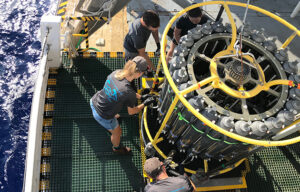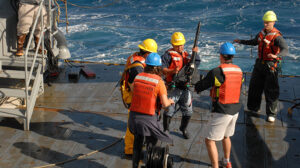Good News for Three Long-Term Ocean-Monitoring Programs at BIOS

Three long-term ocean monitoring programs at BIOS recently received funding renewals from NASA, the National Oceanic and Atmospheric Administration (NOAA), and the National Science Foundation. These renewals will allow BIOS scientists to continue their work studying the underwater light field in the open ocean (the Bermuda Bio-Optics Project), gathering physical oceanographic data as part of the world’s longest-running open ocean time-series (Hydrostation ‘S’), and making measurements as part of a global carbon dioxide time-series to help researchers better understand climate change and the ocean carbon cycle (the NOAA Surface Ocean Carbon Network).
BIOS senior scientist and director of research Nick Bates boosted his research portfolio earlier this month when he received news of three funding renewals for long-term ocean-monitoring programs at BIOS.
These programs are powerful tools in helping researchers understand a changing ocean, as well as the complex processes involved in Earth’s climate system. Over time, long-term ocean monitoring programs can resolve annual changes in function of marine ecosystems and highlight shorter-term features, such as eddies, that play important roles in the physical, chemical, and biological structure of marine ecosystems.

Crew and scientists aboard Atlantic Explorer work to deploy equipment for the Bermuda Bio-Optics Project (BBOP). BBOP makes observations of the underwater light field in the open ocean in conjunction with another long-running time-series program at BIOS, the Bermuda Atlantic Time-series Study. This allows the programs to leverage costly ship time aboard Atlantic Explorer.
Programs funded by the renewals include:
Bermuda Bio-Optics Project
In 1992, the Bermuda Bio-Optics Project was formed to make biweekly to monthly observations of the underwater light field in the open ocean in conjunction with another long-running time-series program at BIOS, the Bermuda Atlantic Time-series Study (BATS). The amount of light available in the open ocean plays an important role in climate-related biogeochemical cycles, such as the carbon cycle, as well as the productivity of phytoplankton and bacteria that live in the water column. However, the transmission of this light is impacted by a variety of components that absorb radiation, such as plankton, detritus and other particulate matter, and colored dissolved organic matter
Scientists working on BBOP analyze water samples for suspended particles to increase our understanding of open-ocean primary productivity and nutrient cycles. At the same time, observations from BBOP are submitted to various NASA databases to help improve algorithms used in a variety of ocean color satellites, such as SeaWiFS (Sea-viewing Wide Field-of-view Sensor), which is used to determine the optical properties of ocean waters.
This project is funded by NASA through 2025.
Hydrostation ‘S’
In 1954, Hydrostation ‘S’ was founded by Henry Stommel as a deep-water research mooring for scientists to gather data on the physical nature of the ocean in an effort to address fundamental questions about ocean currents and air-sea gas exchange. For more than 60 years data from Hydrostation ‘S,’ now the world’s longest-running time-series for physical oceanographic data, have been used for research on a variety of topics, including phytoplankton population dynamics, microbial genomics, paleoclimate reconstructions, and open ocean carbon budgets.
“In the coming years we will look at how data from Hydrostation ‘S’ fits in with data from BATS, including the running of a workshop to focus on this topic,” Bates said. “It’s our goal to see this program go past 100 years.”
This program is funded by the National Science Foundation through 2025.
The NOAA Surface Ocean Carbon Network
Since the early 2000s, BIOS has been part of the National Oceanic Atmospheric Administration’s (NOAA’s) global network of carbon dioxide time-series observations. Measurements from this network include temperature, salinity, and pCO2—the partial pressure of carbon dioxide (CO2), a measurement that helps scientists determine if the ocean is releasing or absorbing CO2 and at what rate. Researchers around the world use this information to better understand climate change and the ocean carbon cycle, and to help inform predictions of future atmospheric CO2 levels.
Last year, a paper published using data from this network showed a drop in CO2 emissions, and a coincidental increase in oceanic uptake during the global COVID-19 lockdown, which Bates says is an example of how we have to confront the climate change crisis. “It shows the issue will be with us for decades,” he said. “Just because emissions stop doesn’t mean impacts of carbon dioxide stop. It’s not instant effects. It’s future generations who will have to think about climate change, so we have to act now.”
This program is funded by NOAA through 2026.
